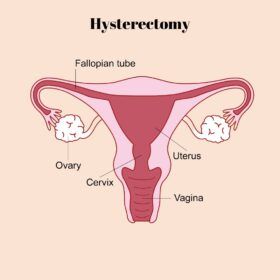
Hysterectomy is the surgical removal of a woman’s uterus. Common types include total, partial, and radical hysterectomy for various medical conditions. Reasons may include fibroids, endometriosis, uterine prolapse, chronic pelvic pain, or gynaecological cancers.
Preparation involves medical evaluation and tests. Recovery takes weeks, with potential hormonal changes and menopause symptoms. Emotional support is essential as fertility is permanently lost.
Despite benefits, women should be aware of the impact on pelvic floor health and psychological aspects. Open communication with healthcare providers empowers women to make informed decisions about their reproductive health and well-being.

Hysterectomy is the partial or total surgical removal of the uterus. It may also involve removal of the cervix, ovaries(oophorectomy), fallopian tubes (salpingectomy), and other surrounding structures. Partial hysterectomies allow for hormone regulation while total hysterectomies do not.
Usually performed by a gynaecologist, a hysterectomy may be total (removing the body, fundus, and cervix of the uterus; often called “complete”) or partial (removal of the uterine body while leaving the cervix intact; also called “supracervical”).
Removal of the uterus renders the patient unable to bear children (as does removal of ovaries and fallopian tubes) and has surgical risks as well as long-term effects, so the surgery is normally recommended only when other treatment options are not available or have failed.
It is the second most commonly performed gynaecological surgical procedure, after caesarean section, in the United States. Nearly 68 percent were performed for conditions such as endometriosis, irregular bleeding, and uterine fibroids.
It is expected that the frequency of hysterectomies for non-malignant indications will continue to fall given the development of alternative treatment options .
Types Hysterectomy, in the literal sense of the word, means merely r removal of the uterus. However other organs such as ovaries, fallopian tubes, and the cervix are very frequently removed as part of the surgery.
● Radical hysterectomy: complete removal of the uterus, cervix, upper vagina, and parametrium. Indicated for cancer. Lymph nodes, ovaries, and fallopian tubes are also usually removed in this situation, such as in Wertheim’s hysterectomy.
● Total hysterectomy: complete removal of the uterus and cervix, with or without oophorectomy.
● Subtotal hysterectomy: removal of the uterus, leaving the cervix (supracervical) hysterectomy was originally proposed with the expectation that it may improve sexual functioning after hysterectomy, it has been postulated that removing the cervix causes excessive neurologic and anatomic disruption, thus leading to vaginal shortening, vaginal vault prolapse, and vaginal cuff granulations.
Hysterectomy is a significant medical procedure that can profoundly impact a woman’s life. It is crucial for women to be well-informed about the different types of hysterectomy, reasons for the surgery, and the potential implications on their health and well-being. By discussing their concerns and treatment options with their healthcare providers, women can make empowered decisions about their reproductive health and overall quality of life.
